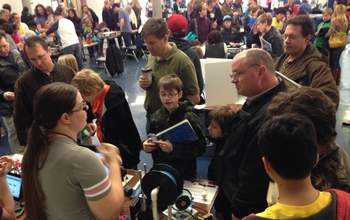All Images
News Release 15-065
New paths to innovation and learning through DIY technologies
During Week of Making, renewed focus on the people who explore the frontiers of design thinking and STEM learning
This material is available primarily for archival purposes. Telephone numbers or other contact information may be out of date; please see current contact information at media contacts.

Additive manufacturing, the technological innovation behind 3-D printing, has revolutionized the way we conceive of and build everything from electronic devices to jewelry to artificial organs.
While both public and private investments contributed to the development of this technology, the National Science Foundation (NSF) provided early funding and continues to provide support for additive manufacturing, totaling approximately $200 million in 2005 adjusted dollars from more than 600 grants awarded from 1986-2012.
Now available for download (https://www.nsf.gov/policies/logos.jsp): Instructions for how to print a three-dimensional National Science Foundation logo using a 3-D printer. Make it in the classroom, the lab, at home or in a local community space. The design is based on the grayscale vector logo and is in the standard CAD format.
Credit: NSF
Download the high-resolution GIF version of the image. (735.5 KB)
Use your mouse to right-click (Mac users may need to Ctrl-click) the link above and choose the option that will save the file or target to your computer.

A social art project based on the classic paint-by-numbers activity helps students practice an essential laboratory skill called pipetting.
The NSF-funded Center for the Advancement of Informal Science Education will demonstrate the activity at the National Maker Faire.
Credit: Carlin Hsueh, World Biotech Tour, ASTC
Download the high-resolution JPG version of the image. (2.9 MB)
Use your mouse to right-click (Mac users may need to Ctrl-click) the link above and choose the option that will save the file or target to your computer.

Morgan Sinko, University of Rochester engineering student, is building a virtual reality suit that allows users to "touch" computer-generated images.
Credit: Morgan Sinko
Download the high-resolution JPG version of the image. (853.6 KB)
Use your mouse to right-click (Mac users may need to Ctrl-click) the link above and choose the option that will save the file or target to your computer.

Students participating in the NSF-funded Tribal Colleges and Universities Program (TCUP) made their own electric guitars.
Credit: Bayan Kelly
Download the high-resolution JPG version of the image. (361.0 KB)
Use your mouse to right-click (Mac users may need to Ctrl-click) the link above and choose the option that will save the file or target to your computer.

Students in the NSF-funded Tribal Colleges and Universities Program learn technical skills through making-related activities.
Shown here is a 3-D printed gear on the wheel in which it will be mounted.
Credit: Tasha Kawamata, University of Hawaii, and Jacob Tyler, Kapiolani Community College
Download the high-resolution JPG version of the image. (959.5 KB)
Use your mouse to right-click (Mac users may need to Ctrl-click) the link above and choose the option that will save the file or target to your computer.

Making is a broad term that includes interests as diverse as 3-D printing, customized robotics, remixing electronics and expressions of STEM and art, so long as it is grounded in open access to tools and expertise.
Makers often work in makerspaces and hold maker events to share what they've created and learned.
The NoVa Mini Maker Faire, shown here, showcased more than 100 makers and demonstrations.
Credit: Ellen McCallie, NSF
Download the high-resolution JPG version of the image. (1.9 MB)
Use your mouse to right-click (Mac users may need to Ctrl-click) the link above and choose the option that will save the file or target to your computer.
_f.jpg)
Technology-enabled resources provide new access to tools for students, such as those in the NSF-funded Tribal Colleges and Universities Program.
3-D printed components, shown above, combine with electronics to form innovative creations.
Credit: Tasha Kawamata, University of Hawaii, and Jacob Tyler, Kapiolani Community College
Download the high-resolution JPG version of the image. (1.6 MB)
Use your mouse to right-click (Mac users may need to Ctrl-click) the link above and choose the option that will save the file or target to your computer.


